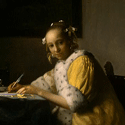Johannes Vermeer is now acclaimed one of the greatest artists who ever lived. A hundred years ago
he was almost unknown, and he still remains among the most mysterious figures in the history
of art. We have no letters, no diary, not a single line written by him. During his lifetime
he is briefly mentioned in print only three times: first in a poem saying he was a phoenix who
rose from ashes of Carel Fabritius, a fellow painter blown to bits by an explosion in Delft;
second time in which only his name occurs; and a third mention in the diary of a
French collector to whom he refused to show his paintings.
In 1665 this potential purchaser, Balthazar de Monconys,
came all the way to Delft to see him and his paintings, but Vermeer refused to show him anything.
The Monconys relates this incident in his diary "... after this rebuff, I was taken to a bakery
where I saw his canvas with a single figure priced at three hunderd florins".
 Almost all of the Vermeer paintings show people and object in simple interiors cut off from the
outside world, demonstrate the profound attachment to the home environment.
On this picture he create a secret, almost divine harmonious relationship between a
woman and the writing table she is sitting at. The portrayed woman wears an expensive
yellow satin jacket trimmed with white fur. The appearance of such a garment in this image may
well indicate that the woman at her writing table is Vermeer's wife Catharina Bolnes. This theory
seems reinforced by the care with which Vermeer modeled the woman's features. Moreover, he has
emphasized her face by posing her as through she
has just looked up after being interrupted. Nevertheless, since the other woman in
collection of his painting wear the same jacket, the identification cannot be confirmed.
Almost all of the Vermeer paintings show people and object in simple interiors cut off from the
outside world, demonstrate the profound attachment to the home environment.
On this picture he create a secret, almost divine harmonious relationship between a
woman and the writing table she is sitting at. The portrayed woman wears an expensive
yellow satin jacket trimmed with white fur. The appearance of such a garment in this image may
well indicate that the woman at her writing table is Vermeer's wife Catharina Bolnes. This theory
seems reinforced by the care with which Vermeer modeled the woman's features. Moreover, he has
emphasized her face by posing her as through she
has just looked up after being interrupted. Nevertheless, since the other woman in
collection of his painting wear the same jacket, the identification cannot be confirmed.
Above all, Vermeer was a painter of light. In his study of optics he undoubtedly used a camera obscura, or "darkened chamber," the ancestor of the modern photographic camera. This scientific device employed an adjustable lens and mirrors to capture reflected light and project the scene onto a viewing screen in its lid. Vermeer analyzed the resulting images carefully because they duplicate the selective focus of the human eye. Only objects at a certain distance from the camera or the eye are in sharp focus. This is exactly the optical effect Vermeer has generated here. Precise white highlights glisten from the writing box, pearl earrings, satin hair ribbons, and the chair's brass tacks -- all of which lie equally in the middle distance. The near tablecloth is purposely blurred, and the painting on the far wall is hazy. This is just as they would look to someone concentrating specifically on the woman. Because she directly faces the viewer with an open gaze, the painting may be a portrait.
Vermeer lived all his life in Delft, that he was a picture dealer and in 1652 he became a master and thus acquired the right to sell his own work. But amazingly he seems to have sold almost nothing. He sold very few paintings during his life time. Paintings generally accepted as by him number fewer than 40 (about 36), and of these it is thought that he still owned 29 including "A Lady Writhing" at the time of his death. When he died in 1675 he left his wife and 11 children with enormous debt. In 1677 "A lady writing" was sold for 300 florens to unknown buyer, who later sold it to Dr. Luchtmans from Rotterdam. After that the painting change hands for several times, to end up as a gift of Harry Waldron Havemayer and Horace Havemayer to Gallery of Art in Washington, where it can be seen.